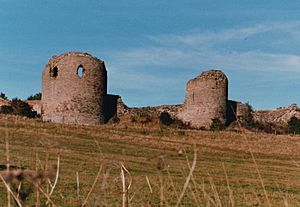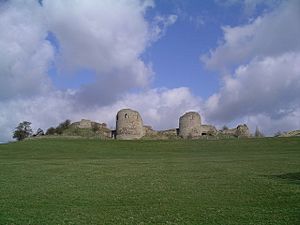Chartley Castle facts for kids
Chartley Castle is an old castle that is now mostly in ruins. It's located near the village of Stowe-by-Chartley in Staffordshire, England. This area is between the towns of Stafford and Uttoxeter. The castle and its old earthworks (like big ditches and mounds) are protected as a Scheduled Monument. This means they are important historical sites. The castle building itself is also a Grade II* listed building, showing its special historical value.
Contents
History of Chartley Castle
The first castle here was a motte and bailey castle. This type of castle was built on a big mound of earth (the motte) with a fenced area below (the bailey). It was built around the year 1100 by one of the early Earls of Chester. They used it as a safe place to stop when traveling to other areas like Tutbury.
The castle was rebuilt in 1220 by Ranulph de Blondeville, 4th Earl of Chester. After he died in 1232, the castle became part of the Ferrers family through marriage. It stayed with the Ferrers family for over 200 years!
In 1453, the castle passed to Walter Devereux. He became Lord Ferrers of Chartley in 1461. Walter Devereux was killed in a famous battle called the Battle of Bosworth in 1485. After this, people stopped living in the castle.
Instead, a new house called Chartley Manor was built nearby. This was a large timber (wooden) mansion with a moat and battlements (like a castle wall). This manor house became famous because Mary, Queen of Scots was held prisoner there for a time. Sadly, Chartley Manor was destroyed by a fire in 1781.
What the Castle Looks Like Now
Even though it's in ruins, you can still see a lot of the old castle today. One special part is a rare round tower called a keep. There's also a curtain wall, which is the main outer wall, with two half-round towers on its sides. You can also see parts of a gatehouse (the entrance building) with two towers, and another angled tower.
In the 1800s, a study of the castle found five towers. They were all quite large, between 35 and 41 feet wide. The main keep was even bigger, about 50 feet wide! Some experts think Chartley Castle looks similar to Montlhery Castle in France. The person who rebuilt Chartley, Ranulph de Blondeville, might have seen that castle. There are also similarities between Chartley, Bolingbroke Castle, and Beeston Castle, which were all likely built by Ranulph de Blondeville.
Mary, Queen of Scots at Chartley Manor
Chartley Manor became one of the last places where Mary, Queen of Scots was held prisoner. At that time, the manor belonged to Robert Devereux, Earl of Essex.
In September 1585, Mary's jailer, Amias Paulet, came to look at Chartley Manor. He thought it was just big enough for both his staff and the queen's staff, though it would be a bit crowded. Chartley Manor was chosen over other places because it had a deep moat around it. The moat was helpful for security, and it even meant Mary's laundry could be washed without her maids leaving the house! Paulet did worry that Mary might not like the house because it was "low and environed with water," meaning it was damp.
Mary was moved from Tutbury Castle to Chartley before Christmas in 1585. She stayed at Chartley for almost a year. In August 1586, a plan was made to arrest Mary. Her jailer, Paulet, pretended to take her hunting. While she was out, the main people in her household were arrested, and her important papers were taken. Many of her servants stayed at Chartley, but Mary was taken to another house.
This happened because of something called the Babington Plot. This was a secret plan to overthrow Queen Elizabeth I and put Mary on the throne. Mary was arrested on August 11, 1586, while she was riding with her doctor and others. Armed soldiers surprised them and took them to Tixall.
Even though Queen Elizabeth I wanted Mary to stay at Tixall, Paulet brought Mary back to Chartley on August 25. However, on September 25, 1586, Mary was moved again. This time, she went to the strong Fotheringay Castle in Northamptonshire. She was executed there on February 8, 1587.
Images for kids





